Structure of the human metapneumovirus polymerase phosphoprotein complex
- PMID: 31698413
- PMCID: PMC6949429
- DOI: 10.1038/s41586-019-1759-1
Structure of the human metapneumovirus polymerase phosphoprotein complex
Abstract
Respiratory syncytial virus (RSV) and human metapneumovirus (HMPV) cause severe respiratory diseases in infants and elderly adults1. No vaccine or effective antiviral therapy currently exists to control RSV or HMPV infections. During viral genome replication and transcription, the tetrameric phosphoprotein P serves as a crucial adaptor between the ribonucleoprotein template and the L protein, which has RNA-dependent RNA polymerase (RdRp), GDP polyribonucleotidyltransferase and cap-specific methyltransferase activities2,3. How P interacts with L and mediates the association with the free form of N and with the ribonucleoprotein is not clear for HMPV or other major human pathogens, including the viruses that cause measles, Ebola and rabies. Here we report a cryo-electron microscopy reconstruction that shows the ring-shaped structure of the polymerase and capping domains of HMPV-L bound to a tetramer of P. The connector and methyltransferase domains of L are mobile with respect to the core. The putative priming loop that is important for the initiation of RNA synthesis is fully retracted, which leaves space in the active-site cavity for RNA elongation. P interacts extensively with the N-terminal region of L, burying more than 4,016 Å2 of the molecular surface area in the interface. Two of the four helices that form the coiled-coil tetramerization domain of P, and long C-terminal extensions projecting from these two helices, wrap around the L protein in a manner similar to tentacles. The structural versatility of the four P protomers-which are largely disordered in their free state-demonstrates an example of a 'folding-upon-partner-binding' mechanism for carrying out P adaptor functions. The structure shows that P has the potential to modulate multiple functions of L and these results should accelerate the design of specific antiviral drugs.
Conflict of interest statement
Figures


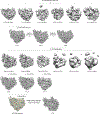
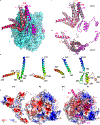

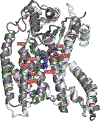


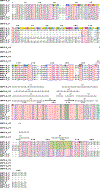
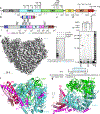
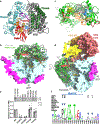

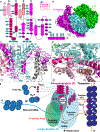
Similar articles
-
Characterization of the Interaction Domains between the Phosphoprotein and the Nucleoprotein of Human Metapneumovirus.J Virol. 2022 Jan 26;96(2):e0090921. doi: 10.1128/JVI.00909-21. Epub 2021 Nov 3. J Virol. 2022. PMID: 34730389 Free PMC article.
-
Cryo-EM structure of the respiratory syncytial virus RNA polymerase.Nat Commun. 2020 Jan 17;11(1):368. doi: 10.1038/s41467-019-14246-3. Nat Commun. 2020. PMID: 31953395 Free PMC article.
-
Bipartite interface of the measles virus phosphoprotein X domain with the large polymerase protein regulates viral polymerase dynamics.PLoS Pathog. 2019 Aug 5;15(8):e1007995. doi: 10.1371/journal.ppat.1007995. eCollection 2019 Aug. PLoS Pathog. 2019. PMID: 31381607 Free PMC article.
-
Structures of the Mononegavirales Polymerases.J Virol. 2020 Oct 27;94(22):e00175-20. doi: 10.1128/JVI.00175-20. Print 2020 Oct 27. J Virol. 2020. PMID: 32847861 Free PMC article. Review.
-
Interactions between the Nucleoprotein and the Phosphoprotein of Pneumoviruses: Structural Insight for Rational Design of Antivirals.Viruses. 2021 Dec 6;13(12):2449. doi: 10.3390/v13122449. Viruses. 2021. PMID: 34960719 Free PMC article. Review.
Cited by
-
Borna Disease Virus 1 Phosphoprotein Forms a Tetramer and Interacts with Host Factors Involved in DNA Double-Strand Break Repair and mRNA Processing.Viruses. 2022 Oct 26;14(11):2358. doi: 10.3390/v14112358. Viruses. 2022. PMID: 36366462 Free PMC article.
-
Insight into the multifunctional RNA synthesis machine of rabies virus.Proc Natl Acad Sci U S A. 2020 Feb 25;117(8):3895-3897. doi: 10.1073/pnas.2000120117. Epub 2020 Jan 28. Proc Natl Acad Sci U S A. 2020. PMID: 31992635 Free PMC article. No abstract available.
-
First insights into the structural features of Ebola virus methyltransferase activities.Nucleic Acids Res. 2021 Feb 22;49(3):1737-1748. doi: 10.1093/nar/gkaa1276. Nucleic Acids Res. 2021. PMID: 33503246 Free PMC article.
-
Cryo-EM structures of Nipah virus polymerases and high-throughput RdRp assay development enable anti-NiV drug discovery.Nat Commun. 2025 Jul 19;16(1):6655. doi: 10.1038/s41467-025-61764-4. Nat Commun. 2025. PMID: 40683863 Free PMC article.
-
Structure of the Newcastle Disease Virus L protein in complex with tetrameric phosphoprotein.Nat Commun. 2023 Mar 10;14(1):1324. doi: 10.1038/s41467-023-37012-y. Nat Commun. 2023. PMID: 36898997 Free PMC article.
References
-
- Pflug A, Guilligay D, Reich S, Cusack S Structure of Influenza A polymerase bound to the viral RNA promoter. Nature 516, 355–60 (2014). - PubMed
Publication types
MeSH terms
Substances
Grants and funding
LinkOut - more resources
Full Text Sources
Research Materials
Miscellaneous

